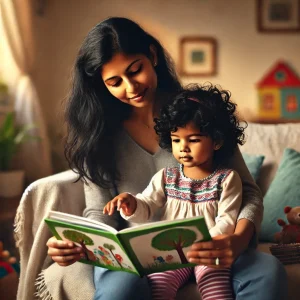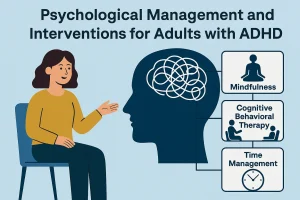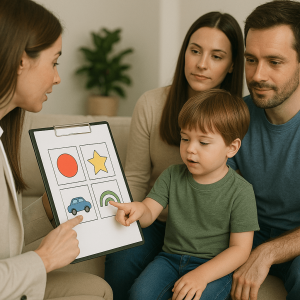Using Positive Reinforcement to Enhance Your Child’s Focus
Last Updated: September 18, 2024
As a parent, you’ve probably heard a lot about positive reinforcement, but what does it really mean, and how can it help your child focus better? Positive reinforcement is a simple yet powerful tool that involves rewarding your child when they display the desired behavior, like paying attention during homework or completing a task without getting distracted. It’s not just about giving out rewards; it’s about recognizing and encouraging the behaviors you want to see more of in your child.
Focus is a crucial skill for children, not just in school but in every aspect of their lives. When a child can concentrate well, they’re more likely to succeed academically, build better relationships, and develop essential life skills. However, staying focused can be a real challenge, especially in today’s world filled with distractions. That’s where positive reinforcement comes in.
Also read: Understanding Behavioral Therapy: A Simple Guide for Parents
Understanding Positive Reinforcement
Positive reinforcement is all about encouraging good behavior by offering something desirable in return. Think of it as a simple exchange: when your child does something positive, like staying focused during homework or following instructions, you acknowledge that behavior with praise, a reward, or even just a smile. This response reinforces their actions, making it more likely they’ll repeat the behavior in the future. In essence, positive reinforcement helps children learn what is expected of them in a positive and supportive way.
Let’s break it down with some examples. Imagine your child completes their assignments without getting distracted. A quick “Great job finishing your work without distractions!” can go a long way. Other forms of positive reinforcement include small rewards like stickers, extra playtime, or even a fun activity they enjoy. Encouraging words, high-fives, and a proud hug also count as positive reinforcement—sometimes, it’s the little things that matter most.
Benefits of Positive Reinforcement for Enhancing Focus
Positive reinforcement can do wonders for your child’s focus, but its benefits go even further. Let’s look at how it helps your child grow and stay on track.
1. Builds Confidence and Self-Esteem
When kids are praised or rewarded for focusing, they feel good about themselves. Simple words like “Great job paying attention!” boost their confidence. This makes them more willing to try again, even when things get hard.
2. Creates a Positive Learning Environment
A positive learning environment is one where kids feel supported and appreciated. Positive reinforcement shifts the focus from what’s wrong to what’s going well. This makes learning more fun and less stressful, helping your child stay engaged and focused.
3. Encourages Persistence and Effort
Staying focused isn’t always easy, but when kids know their efforts are noticed, they’re motivated to keep going. Positive reinforcement teaches them that their hard work matters, which helps them stay focused, even on tough tasks.
4. Helps Develop Routine and Consistency
Routine and consistency are key to good focus. Positive reinforcement helps build these habits. For instance, rewarding your child for doing homework at the same time each day can help them get into a focused mindset naturally.
Also read: Top Positive Reinforcement Methods for Parents
Practical Strategies to Use Positive Reinforcement
Now that we’ve covered the basics, let’s dive into some practical strategies you can use to reinforce positive behavior and improve your child’s focus. These tips are simple to implement and can make a big difference in your daily routine.
1. Start Small
It’s best to begin with short periods of focused activity. For example, if your child struggles to concentrate on homework, start by reinforcing just five minutes of focused effort. Celebrate those small wins with a quick praise like, “I love how you worked hard for those five minutes!” Gradually, you can increase the time as your child gets used to staying focused. Starting small makes the process less overwhelming and sets your child up for success right from the start.
2. Be Specific
When you praise your child, be specific about what they did well. Instead of saying, “Good job,” try something like, “Great job staying focused on your homework!” This way, your child knows exactly what behavior is being recognized, which makes it more likely they’ll repeat it. Specific praise helps your child understand what behaviors lead to positive outcomes, reinforcing their ability to concentrate on tasks.
3. Use Rewards Wisely
Rewards don’t have to be big or costly to be effective. Sometimes, a small reward like a sticker, a few extra minutes of playtime, or choosing the next family movie can be enough to motivate your child. The key is to match the reward to the effort. For example, if your child completes a particularly challenging task, a slightly bigger reward might be appropriate. However, be careful not to overuse rewards, as the goal is to gradually reduce the need for them as your child’s focus improves.
4. Consistency is Key
Consistency is one of the most important aspects of positive reinforcement. To build habits, it’s crucial to reinforce focused behavior regularly. If your child sees that their efforts are consistently acknowledged, they’ll be more likely to keep up the good work. Make it a point to notice and praise their focus every day, even for small achievements. Over time, this consistent reinforcement will help them develop a habit of concentrating without needing as much external encouragement.
Common Mistakes to Avoid
While positive reinforcement is a powerful tool, it’s easy to make some common mistakes that can undermine its effectiveness. Let’s look at a few pitfalls to avoid so you can make the most out of your efforts to enhance your child’s focus.
1. Overuse of Rewards
One common mistake is relying too heavily on rewards for every task. While rewards can be motivating, overusing them can make your child dependent on external incentives rather than developing an internal drive to focus. The goal is to gradually shift from tangible rewards, like stickers or extra screen time, to intrinsic rewards, such as the satisfaction of completing a task. Start by rewarding frequently, then slowly reduce the frequency as your child builds confidence and independence. Remember, positive reinforcement isn’t just about rewards—it’s also about recognition, praise, and encouragement.
2. Inconsistency
Consistency is key when it comes to positive reinforcement. If you only sometimes acknowledge your child’s efforts, they might get confused about what behaviors are expected. Regular reinforcement helps children understand what they are doing right and encourages them to keep it up. Make it a habit to provide reinforcement consistently, even if it’s just a quick “Good job staying focused!” This consistency helps in forming strong habits and keeps your child on track.
3. Unclear Expectations
Children thrive when they know exactly what’s expected of them. If your praise or rewards are vague, your child might not understand which behavior you are reinforcing. For instance, instead of saying, “You’re doing great!” be specific: “I really like how you concentrated on your reading without getting distracted!” Clear expectations help your child understand the specific actions that lead to positive reinforcement, making it more likely they will repeat those behaviors.
Examples of Positive Reinforcement in Everyday Activities
Positive reinforcement can be easily used in your child’s daily activities to help them focus better. Here are some simple ways to apply it during common routines.
1. During Homework Time: Praise Focus and Quiet Sitting
Homework can be tough, but using positive reinforcement can make it smoother. If your child sits quietly and focuses on their homework, acknowledge it with a specific praise like, “Great job staying focused on your homework!” You can also offer small rewards, like a short play break or a favorite snack once a task is done. This makes homework time more positive and encourages your child to keep focusing.
2. In Play: Encourage Focused Play with Toys or Games
Playtime is another chance to use positive reinforcement. When your child focuses on building with blocks or finishing a puzzle, give them a quick “Wow, you’re really concentrating well!” This boosts their confidence and helps them stick with tasks. You can also let them pick the next game or give a small treat as a reward for focused play.
3. Daily Routines: Reinforce Morning and Bedtime Habits
Positive reinforcement works well with daily routines, like getting ready in the morning or bedtime. If your child follows their morning routine—like brushing teeth and getting dressed—praise them with a “Great job getting ready by yourself!” For bedtime, if they follow the steps—like putting on pajamas and going to bed—acknowledge it with a hug or a “Good job sticking to your bedtime routine!” This helps build good habits and keeps them on track.
How to Tailor Positive Reinforcement to Your Child’s Needs
Positive reinforcement works best when it’s tailored to your child’s unique needs and preferences. Here’s how you can customize your approach to make it more effective for your child.
1. Understand Your Child’s Interests and Preferences
Every child is different, so it’s important to understand what makes your child tick. Does your child love stickers, extra playtime, or words of praise? Pay attention to what excites them the most. If your child loves drawing, a reward could be a new set of crayons or some extra time to draw. By aligning rewards with their interests, you’re more likely to motivate them and see better results.
2. Adjust Reinforcement Techniques Based on Age and Developmental Level
Positive reinforcement isn’t one-size-fits-all. Younger children might respond well to immediate rewards like a small toy or a treat, while older kids might appreciate a later reward, such as earning points towards a bigger goal. Also, consider their developmental level—what works for a preschooler may not work for a teenager. For younger kids, simple praise like “Great job!” might be enough, while older children may benefit from more specific feedback, such as “I noticed how well you focused on your reading today.”
3. Be Patient and Make Adjustments as Needed
Patience is key when using positive reinforcement. Sometimes, you might not see immediate changes, and that’s okay. If a certain reward or type of praise isn’t working, don’t hesitate to switch it up. Pay attention to how your child responds and adjust your approach as needed. It’s a process of trial and error, and what matters most is finding what works best for your child. Keep trying, and remember that small steps forward are still progress.
Age-Appropriate Reinforcement Techniques
| Age Group | Reinforcement Techniques | Explanation |
|---|---|---|
| Toddlers (1-3) | Immediate praise, small toys, stickers | Toddlers respond well to instant feedback. Use cheerful verbal praise (“Great job!”) immediately after the desired behavior, or small rewards like stickers or small toys. |
| Preschoolers (3-5) | Verbal praise, simple games, favorite activities | Preschoolers enjoy recognition and play. Offer praise that acknowledges their effort and behaviors, and reward with time for simple, fun activities they enjoy, like a favorite game. |
| School Age (6-12) | Points system, extra playtime, small privileges | School-aged children can understand delayed gratification. Use a points system where they earn rewards over time, such as extra playtime, screen time, or choosing a family activity. |
| Teens (13+) | Verbal recognition, time with friends, special outings | Teens appreciate independence and social recognition. Use praise that respects their growing autonomy, and offer rewards like time with friends, extra screen time, or outings of their choice. |
Conclusion
Positive reinforcement is an easy and effective way to help your child improve their focus. By giving praise, rewards, and encouragement, you can guide your child to better concentrate during activities like homework, playtime, and daily routines. It’s about making them feel good about their efforts, which boosts their confidence and helps build good habits. Remember, you don’t need to make big changes all at once—start small, like praising them when they stay focused for a few minutes, and gradually build from there.
The key to success with positive reinforcement is patience and consistency. Don’t worry if you don’t see results right away. Keep reinforcing the good behaviors, and over time, you’ll notice improvements. Creating a positive environment where your child feels supported will make a big difference. For more tips and support on using positive reinforcement, check out the resources at Wellness Hub. Every small step you take helps your child grow, and your encouragement will go a long way.
Frequently Asked Questions:
1. How can positive reinforcement improve my child’s focus?
Positive reinforcement improves focus by encouraging and rewarding the specific behaviors you want to see more of, like sitting quietly or completing a task. When children receive praise or small rewards for focusing, they’re motivated to keep doing it, which helps build strong concentration habits over time.
2. What are some examples of positive reinforcement for kids?
Examples of positive reinforcement for kids include verbal praise like “Great job focusing on your homework!” small rewards such as stickers, extra playtime, or letting your child choose a favorite activity. These rewards help reinforce positive behaviors like focusing and following routines.
3. How often should I use positive reinforcement with my child?
Consistency is key, so try to use positive reinforcement regularly. Praise your child whenever they display the desired behavior, even if it’s just a small effort. Over time, you can reduce the frequency of rewards as your child develops the habit of focusing on their own.
4. What should I avoid when using positive reinforcement?
Avoid overusing rewards, as this can make children dependent on them for every task. Also, be consistent with your reinforcement and set clear expectations, so your child knows exactly what behavior is being rewarded.
5. How do I tailor positive reinforcement to my child’s needs?
Tailor positive reinforcement by understanding your child’s interests and preferences. Use rewards that they find motivating, and adjust your approach based on their age and developmental level. Be patient and willing to make changes if something isn’t working.
6. Can positive reinforcement be used for all ages?
Yes, positive reinforcement can be used for all ages, but the methods may vary. Younger children may respond better to immediate rewards, like a treat or a sticker, while older children might appreciate delayed rewards or verbal praise that acknowledges their effort.
7. How long does it take to see results with positive reinforcement?
The time it takes to see results can vary from child to child. Some children may respond quickly, while others might take longer. The key is to be consistent and patient, reinforcing the desired behaviors regularly. Over time, you should start to see positive changes in your child’s focus.
8. What if my child doesn’t respond to positive reinforcement?
If your child doesn’t respond to positive reinforcement right away, don’t get discouraged. It might take some time to figure out what type of reinforcement works best for them. Try different rewards, adjust your approach, and make sure the expectations are clear. Consistency and patience are key.
9. Can positive reinforcement be used alongside other behavior strategies?
Yes, positive reinforcement can be combined with other behavior strategies, such as setting clear rules, creating routines, and using gentle reminders. It works well with other approaches because it focuses on reinforcing what your child is doing right, making it a flexible and supportive tool in your parenting toolkit.
10. How can I gradually reduce the need for rewards?
To reduce the need for rewards, slowly start spacing them out as your child’s focus improves. Instead of rewarding every instance, begin acknowledging every other effort, then every few times. Shift more towards verbal praise and recognition, helping your child feel proud of their achievements without always expecting a tangible reward. The goal is to help them internalize the satisfaction of focusing and completing tasks.
About Author:
Lasya Vooturi,
Clinical Psychologist (A) & Behavioral Therapist
Lasya holds a Professional Diploma in Clinical Psychology from Amity University, where she deepened her understanding of psychological principles from March 2023 to March 2024. With over a year of dedicated experience as a Behavioral Therapist, Lasya has honed her skills in applying effective therapy techniques tailored to individual needs. Fluent in Telugu, Hindi, and English, she is adept at connecting with a diverse range of clients, ensuring comprehensive communication and understanding. Lasya’s approach is grounded in empathy and scientific rigor, making her a trusted ally in navigating mental health challenges.
Book your Free Consultation Today
Parent/Caregiver Info:
Client’s Details:
* Error Message









